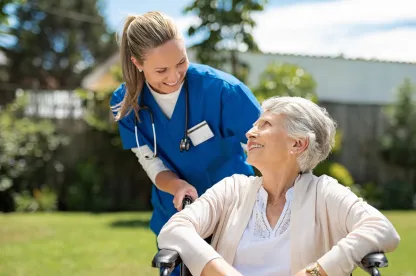Nursing homes and long-term care facilities were hit hard by COVID-19. However, as of September 11, 2022, 87.3% of residents and 86.9% of staff have completed primary vaccination. Such adherence may have been instrumental in the US Department of Health and Human Services’ (HHS’s) decision on September 23, 2022, to update its guidance regarding long-term care facility COVID-19 testing and vaccination requirements.
IN DEPTH
Long-Term Care Facility COVID-19 Testing Guidance
Under 42 CFR 483.80(h), long-term care facilities are required to test all residents and staff for COVID-19 based on parameters and a frequency set forth by the HHS Secretary. These parameters have evolved throughout the pandemic, and on September 23, 2022, HHS revised its expectations for long-term care facilities regarding the testing of asymptomatic staff and individuals who have recovered from COVID-19.
Material changes contained in the HHS guidance include the following:
-
Staff are expected to report to the applicable internal occupational health or designated facility point of contact, regardless of their vaccination status, (1) a positive viral test for SARS-CoV-2; (2) symptoms of COVID-19; or (3) an exposure of an individual’s eyes, nose or mouth to potentially infectious material originating from someone with SARS-CoV-2 infection.
-
Routine testing of COVID-19 is no longer generally recommended for staff without other risk factors present, but facilities have discretion to impose their own internal requirements, subject to state or local rules.
-
Staff and residents who show signs or symptoms of COVID-19 infection, irrespective of vaccination status, should be tested as soon as possible. In the case of staff, they should be restricted from the facility in accordance with Centers for Disease Control and Prevention (CDC) guidance pending the result of their testing. Residents should be placed on transmission-based precautions in accordance with CDC guidance, with appropriate actions taken based on the results.
-
If a long-term care facility experiences a single new case among residents or staff, an investigation should be initiated to determine if others have been exposed. No such investigation is required if a resident with known COVID-19 or known close contact with someone with known COVID-19 is admitted directly into transmission-based precautions and develops COVID-19 before transmission-based precautions are discontinued. Contact-tracing and testing or facility-wide testing of staff and residents should begin 24 hours after the exposure, if known.
-
CDC has developed new guidance for managing long-term care facility admissions, readmissions and short-term departures from the facility. In counties where community transmission levels are high, residents should be tested at admission. In counties with lower levels of community transmission, facilities have discretion to test new admissions. If testing at admission is negative, facilities should retest 48 hours after the first negative test and again 48 hours after a second negative test. Admitted residents should wear source control for 10 days post-admission. Residents who depart the facility for 24 hours or more should be considered akin to an admission.
-
Facilities should have policies and procedures in place to address residents who refuse testing. The procedures should ensure that residents who refuse testing are managed in accordance with CDC guidance for the use of transmission-based precautions.
-
Individuals who have recovered from SARS-CoV-2 infection in the prior 30 days do not require continued testing if they are asymptomatic. If recovery occurred within the prior 31-90 days, testing using an antigen test rather than nucleic acid amplification should be considered.
Long-Term Care Facility Visitation Guidance
During the initial months of the COVID-19 pandemic, HHS restricted visitation at long-term care facilities as a way to quell the surge of infections among vulnerable residents. Isolation had a significant impact on residents’ physical and mental health, however. HHS has since lifted its visitation restrictions and emphasized that resident autonomy is paramount. As a condition of participation in Medicare, long-term care facilities must ensure that residents have the right to receive visitors of their choosing in a manner that does not impose on the rights of another resident, and have the right to deny or withdraw consent for a visit at any time.
Recognizing the challenging interplay between infection control and patients’ rights, HHS has occasionally provided guidance regarding how facilities can balance residents’ visitation rights with facilities’ infection control obligations. In its most recent guidance issued on September 23, 2022, HHS added more color regarding best practices related to face coverings and vaccination requirements.
-
Facilities are now encouraged to provide guidance, such as signs posted at entrances, that discuss recommended actions for visitors who have a positive COVID-19 test, are showing symptoms of COVID-19 or have had close contact with someone with COVID-19.
-
Guidance should encourage visitors with COVID-19 infection or compatible symptoms to defer nonurgent in-person visits until they meet CDC criteria for ending isolation applicable to healthcare settings.
-
Visitors who have had close contact with an individual with COVID-19 infection are encouraged to defer nonurgent in-person visits until 10 days after their close contact if they are not able to wear respirators or well-fitting facemasks or cloth masks.
-
-
Facilities should encourage physical distancing during peak visitation times and large gatherings.
-
If community transmission in the nursing home’s county is high, everyone in the facility should wear face coverings or masks. If community transmission is not high and the facility is not experiencing an outbreak, facilities may choose to require visitors to wear face coverings or masks in the facility. Policies regarding face coverings and masks should be based on recommendation from applicable local, state and federal health departments and the facility’s individual circumstances.
-
Visitors in an individual resident’s room or a designated visitation room should be advised of the risk of physical contact but may choose not to wear face coverings or masks and may choose to have close contact. If a roommate is present during the visit, facilities should explain that it is safest for the visitor to wear a face covering or mask.
-
If a facility is undertaking an outbreak investigation, visitors must still be allowed in the facility but should be made aware of potential risk. Facilities should limit visitor movement in the facility, and visitors should physically distance themselves from other residents and staff, when possible.
-
Individuals at high risk for severe illness should be encouraged to wear a face covering or mask when engaged in communal activities, dining and when leaving the facility for an outing. Upon return from an outing, residents should be screened for signs or symptoms of COVID-19 according to CDC guidance. Quarantine is generally not recommended for situations where the resident leaves the facility for less than 24 hours.
Conclusion
Nursing homes and long-term care facilities are likely to be vulnerable to COVID-19 outbreaks long into the future. The new guidance from HHS regarding testing and visitation provides helpful parameters to balance residents’ rights and facilities’ infection control obligations. Facilities should continue to monitor CDC infection prevention and control recommendations for healthcare personnel when developing policies and procedures for providing COVID-19 tests to residents and staff and allowing residents to have visitors.




 />i
/>i
